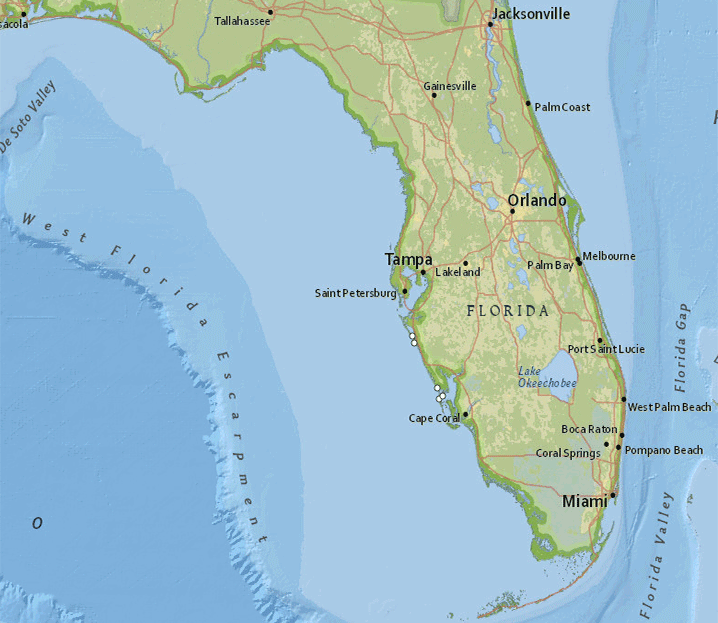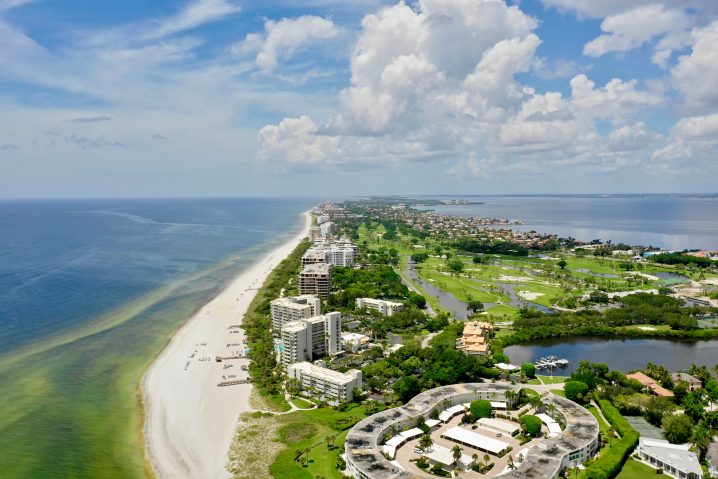The current Florida red tide has been going since October 2017. Over the last 12 months, it has killed huge numbers of fish and other sea animals like manatees, turtles, and birds. It has sent a lot of people to hospital and has cost Floridians tens of millions of dollars. Red tide, in short, is the worst.
But what exactly is red tide? Where did it come from? And why is it such a big problem? You can find the answer to all these questions and more in this handy explainer.

What Is Red Tide?
Red tides are the result of a massive bloom of algae. They’re also known as Harmful Algae Blooms (HABs for short) and show up all over the world every year. They’re perfectly natural and, usually, they’re not a major problem. But obviously, that’s not the case in Florida right now.
The main concern with the Florida red tide is the type of algae we’re dealing with: karenia brevis. When it blooms, it produces neurotoxins that poison fish and other sea creatures. It also causes all kinds of harm to the communities it hits, from damaging our health to threatening our jobs.
When Is Red Tide Season in Florida?
As we’ve already mentioned, algae blooms are perfectly natural in Florida. The thing that makes this one different is how long it’s been going. Red tides usually get going in late summer or early fall and peter out as the weather cools down.
So that means it’s almost over, right? Wrong. This Florida red tide ran all through the winter last year and experts at the NOAA say there’s no guarantee it won’t do the same again. Past red tides have gone on even longer than this one. In fact, the 1994 red tide lasted an incredible 30 months before it finally went away.

What Causes Red Tide in Florida?
Algae blooms need a few things to get big: sunlight, nutrients, and the right temperature and salt levels. When you get these factors, you get algae. Most algae blooms start way offshore and don’t cause much harm. The problems start when the currents and winds send them inshore. That’s when a bloom becomes a red tide.
The reason the current Florida red tide is causing so much trouble is the amount that it’s spread. It started in Southwest Florida, but moved up to the Panhandle in September 2018 after Tropical Storm Gordon. A few weeks later, it even made its way out of the Gulf and has been working its way up Florida’s Atlantic Coast ever since.
Is Red Tide Caused by Pollution?
There are a lot of theories about how and why this red tide has gotten so bad. Some say climate change. Others think it’s water pollution. A few people think it’s just bad luck. The truth is that we don’t really know what makes some red tides worse than others. It’s quite possible we’re having an effect on it, though. Here’s why.
Different algae like different temperatures. The algae in Florida like it warm. The seas are getting warmer. This could explain why the red tide made it through the winter without skipping a beat.

Red tides also need plenty of food to get big. Some experts blame the fertilizer runoff from local agriculture and nutrient-rich water released from Lake Okeechobee. As the Florida Wildlife Commission points out, algae blooms start too far offshore for this to cause them. It can definitely have an effect once they move inshore, though.
Is Red Tide Harmful to Humans?
It can be. Red tide doesn’t hit us nearly as hard as it hits fish or manatees, but it can still cause problems. It gives some people rashes, mainly people swimming in affected areas. If you’re on a boat or on dry land you’re not normally at risk.
Red tide can also trigger breathing problems. Florida’s Environmental Health Program reports that hospital visits for pulmonary issues increase by around 54% during red tides. This mainly affects people with conditions like asthma or bronchitis.
The final thing to watch out for is Neurotoxic Shellfish Poisoning. Fish are fine to eat as long as you remove the skin and guts, but shellfish can be contaminated. Don’t worry, at-risk fisheries are closed for harvest. You can still enjoy a tasty clam chowder, just don’t go scalloping in off-limits areas.

In short, red tide can be a danger to people with respiratory problems like asthma. It can also give you trouble if you swim in it or eat it. Stay clear of affected beaches and you should be fine, though.
What are the Effects of Red Tide?
Red tide causes Florida all kinds of headaches. It damages the environment, it affects businesses, and it generally makes life unpleasant for anyone who has to put up with it (imagine waking up to the smell of rotten fish every day). Here’s a summary of the fallout from the current red tide in Florida.
The Environmental Impact
There’s no way to sugarcoat it, things aren’t looking great for Florida’s marine life. Staggering numbers of dead fish have washed up around the state over the last year. Lee County alone has reported more than 1,700 tons since August. It’s not just fish, either. Manatees, birds, dolphins, turtles, and shellfish have all been hurt by this rusty plague.

The FWC has brought in special measures to protect vulnerable species. Snook and Redfish are catch-and-release only until May 2019 all the way from Naples to the Tampa Bay and beyond. Scallop season also closed early, even in famous shellfishing hotspots like Port St Joe. Who knows what other closures could be needed before this is over?
The Economic Impact
It’s no secret that the Sunshine State relies heavily on tourism. Over the last year, red tide has put a real dampener on Florida’s tourist economy. This hit charter captains, restaurants, and hotels hard. Just look at Sarasota.
In a survey released at the end of August, 100% of Sarasota County businesses reported losses compared to the previous year. 46% said that business was down by more than half. Another 35% said that business was down by over a quarter. The total reported losses in August were over $3,000,000. And that’s just one county.
The impact on commercial fisheries could be even higher. The Florida Health Department estimates that the fishing industry loses as much as $25,000,000 during every major red tide. Add in the public costs of fighting the algae and cleaning up the damage, and you’re looking at tens of millions of dollars at least.

The Political Impact
With so much disruption, red tide has become a major talking point in Florida. And in case you didn’t know, 2018 is an election year. Senate, Congress, and Governor election races have all been running throughout the red tide crisis.
Accusations of poorly-managed waterways and unnecessary budget cuts have been fired in all directions. Many politicians blame sugar farms openly. It’s been a difficult election season for a state with so much depending on tourism and agriculture. There’s even talk of moving away from party politics and focusing on one key issue: clean water policies.
Can Red Tide Be Prevented?
Sadly, Florida will always have red tides. We might be able to stop them from getting this bad, though, and water and waste management could well be the key. The City of Sarasota certainly seems to think so. It recently installed high-tech stormwater filters to catch nutrients heading into the bay. This effectively cuts the food supply for the algae.
Other groups are researching ways to tackle red tide once it hits. The State of Florida is funding research into using “modified clays” to kill it. These clays soak up the algae as they sink and pull it down to the bottom where it can break down safely. It’s a tactic used in Korea and China, but it’s never been tried on a large scale in Florida.

Whatever the plan for getting rid of it, there’s one thing that everyone can agree on about red tide: we want it gone. When will this red tide turn? Only time can tell. For now, let’s hope that it doesn’t spread any farther and that fisheries and businesses make it through in one piece.
Do you live in an affected area? How does this year compare to red tides in the past? Let us know your thoughts and your stories in the comments section below.